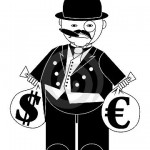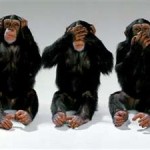Anyone who has ever spent time on an exchange’s trading floor goes through a progression of observations.
 First, any observer is awed at the commotion. There are the coats of different colors, the trader’s frenzy, the enormity of the closed space, the roar, clutter of papers and the mix of all types, sizes and races of people milling or racing about without any apparent pattern.
First, any observer is awed at the commotion. There are the coats of different colors, the trader’s frenzy, the enormity of the closed space, the roar, clutter of papers and the mix of all types, sizes and races of people milling or racing about without any apparent pattern.
But over time, the scene becomes more understandable. An observer soon can discern the various roles, ranks, seniorities and power of the various traders and staff. An observer will then see the actual order of the trading floor, including its bid-offer and order routing process.
But if an observer becomes a regular visitor to any trading floor, they will notice its tenor and temperament. The trading bursts are eclipsed by periods of boredom. The trading comes in ebbs and flows, so there is time for traders on the floor and upstairs in front of computers, to compare notes, speculate on order floors, trading directions, and even go into a corner to devise more novel, untraditional trading strategies designed to obtain a larger, less risky, consistent profit.
As someone who has been on almost every major trading floor in the U.S., stock and futures, I believe the same process applies to all types of trading floors, open outcry and electronic. There may be cultural differences between the different types of trading floors, but the traders’ motives and profit-seeking focus is universal.

That is why the recent disclosures of bid rigging on the LIBOR (London Interbank Bank Offer Rate), as well as the current investigations into manipulations of the $5.2 trillion foreign exchange markets are breathtaking in their audacity.
These alleged multi-bank manipulations by traders representing the world’s largest banks are unprecedented in scope and impact, yet mundane in purpose. The fact is that traders cannot be profitably engaged in daily trading and remain profitable over time unless they are extremely talented or have some inside edge on the other competing market participants. This edge has to be maintained in order to generate the excessive profits needed to keep top management financially secure.
They are also needed to maintain the established hierarchy of leading banks. That is why these investigations naturally involve the world’s largest banks: Barclays, Rabobank, Citigroup, JP Morgan Chase, UBS, Deutschebank, Credit Suisse, and Royal Bank of Scotland.
These investigations follow after some of the largest forced financial settlements for wrongdoing ever made: $1.56 billion against UBS, and a reported $6 billion against Bank of America, $4 billion against JP Morgan, and $1.92 billion against HSBC for laundering drug money for the Mexican cartel, and $327 million against Standard Chartered Bank, to name a few.
In 2012, banks paid a record $11 billion in fines and that figure could be higher in 2013.
Never Give a Sucker An Even Break
Yet as the average investor strains to understand the scope of these worldwide abuses, most fail to understand that the financial services industry walks a thin line between customer abuse and customer service, between giving customers the benefit of the doubt and never giving a sucker an even break.
As a Bloomberg news report found:
“The $5.2-trillion-a-day currency market, the biggest in the financial system, is one of the least regulated. The inherent conflict banks face between executing client orders and profiting from their own trades is exacerbated because most currency trading takes place away from exchanges.”
That is to say, the LIBOR scandal is unfolding in an unregulated market which exists alongside the regulated financial marketplace which has seen an even-increasing number of larger front-running and insider trading scandals. The similarities have to be noticed since front-running and insider trading is what drives the most profitable banks and trading firms over time. Yes, there are individual trading firms and managers who can post five or ten years of above-index market returns, but their days are statistically numbered. Over time, their performance will revert to the mean, or tot the index market averages.
But the front-running model in its various forms can pay off big in the short run for some. In the LIBOR case, the bid-rigging has been going on for decades.

Again the Bloomberg story said this has been going on for a least a decade and involved trillions of dollars in loans, including mortgage loans made to unsuspecting home buyers, tied to the rigged LIBOR rates:
“Employees have been front-running client orders and rigging WM/Reuters rates by pushing through trades before and during the 60-second windows when the benchmarks are set, said the current and former traders, who requested anonymity because the practice is controversial. Dealers colluded with counterparts to boost chances of moving the rates, said two of the people, who worked in the industry for a total of more than 20 years.”
More Common Than You Think
While there are no official statistics on front-running and insider trading aside from legal case data, my bet is that the undetected number of insider trading instances far exceeds the number of individuals caught.
One personal story may provide an example. In the early 1990s, I did some marketing work for a hedge fund in the Bear Stearns building on Park Avenue, where its prime brokerage operations were headquartered. Hedge funds there received free rent and other perks if they became clients of the Bear Stearns prime brokerage services.
After about six months on the project and working on some delicate, intricate language explaining the firm’s investment strategy, the project was finally completed. At my last meeting, the managing partners distilled their real trading strategy for me: “Basically, we take many, many NYSE specialists to lunch and eventually we can find out what their clients are going to do. That is our trading strategy.”
So with the addition of near-instantaneous trade executions and an army of highly-paid consulting snoops to discover revealed and unrevealed trading plans, insider trading should be considered a permanent feature of trading. Sure this hurts individuals, as well as some less-aggressive institutional investors, but that is only collateral damage. When hundreds of thousands of people per day pay a few dollars more for a loan, there really is no huge cause for concern. Instead, the big returns and bonuses make this game very attractive, even essential, for select trading and investment banking executives who want to maintain their lifestyles.
The only takeaway for individual investors is to accept that big-rigging and insider trading are risks which cannot be avoided. Let the active managers and individual investors take price and volatility risks. If they suffer enough fund redemptions or their trading records become more volatile, some big firms may even ask to call in the regulators. But that is a remote possibility. After all, the prevailing policy is to let the big boys have their fun, even if untold thousands of bystanders worldwide get hurt in the frenzy.










